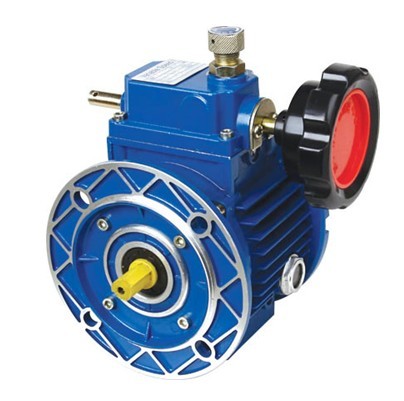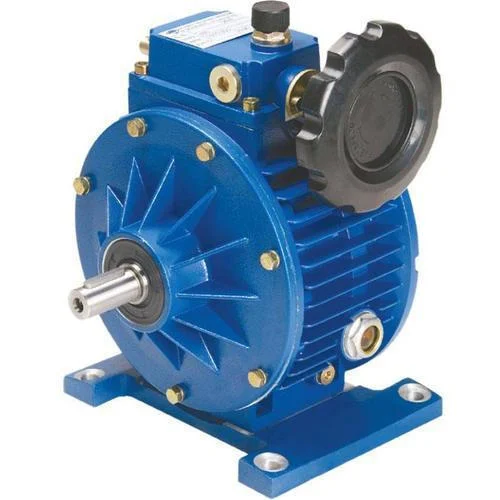Product Description
Stepless speed Variator
High modularity
– Matched with a large range of gearboxes, they are suitable to modular assembling of flanges, feet and torque arms.
High versatility
– 11 sizes, more than 200 versions, with wide range of different mounting positions.
High performances
– Power from 0.18 kW to 7.5 kW.
– Max torque 3000 Nm.
– Up to 6000 Nm when combined with bevel helical gearboxes.
– With the differential device, output speed can be brought to “zero” speed, when the motor is running.
High reliability
– Strengthened box for heavy duty applications.
– Planets and races are made in special steel 100Cr6 and are in oil bath, that guarantee the best conditions of transmission of the motion by friction.
The design of UDL series stepless speed variator compromises the advanced technology both at home and abroad. The products include the following main characteristics:
1. High speed-regulating precision: up to 0.5-1 rotation.
2. Large speed -changing range: The speed ratio ranges from 1:1.4 to 1:7 freely.
3. High in strength and long in service life.
4. Convenient to regulate the speed.
5. Continuous in running, front-to-back in running direction, smooth in driving, stable in performance and low in noise.
6. Full in sealing and suitable for any environment.
7. Compact in structure and small in volume.
8. Made of high-quality aluminum alloy die cast into forming, good-looking in appearance, light in weight and it never gets rusty.
9. Good in adaptation: UDL series stepless speed variators can be combined with all kinds of speed reducers, as to achieve low stepless speed changing.
FAQ
1, Q:what’s your MOQ for udl speed contorller ?
A: 1pc is ok for each type electric gear box motor
2, Q: What about your warranty for your stepless governor ?
A: 1 year ,but except man-made destroyed
3, Q: which payment way you can accept ?
A: TT, western union .
4, Q: how about your payment way ?
A: 100%payment in advanced less $5000 ,30% payment in advanced payment , 70% payment before sending over $5000.
5, Q: how about your packing of speed reduction motor ?
A: plywood case ,if size is small ,we will pack with pallet for less 1 container
6, Q: What information should be given, if I buy electric helical geared motor from you ?
A: rated power, ratio or output speed,type ,voltage , mounting way , quantity , if more is better ,
| Application: | Motor, Machinery, Agricultural Machinery |
|---|---|
| Hardness: | Hardened Tooth Surface |
| Installation: | Horizontal Type |
| Layout: | Bevel |
| Step: | Double-Step |
| Type: | Bevel |
| Customization: |
Available
| Customized Request |
|---|

What factors should be considered when selecting the right variator gearbox for an application?
When selecting the right variator gearbox for an application, several factors should be considered to ensure optimal performance and compatibility. Here are the key factors to take into account:
- Load Requirements: The first consideration is the load requirements of the application. Determine the torque and speed range needed for the gearbox to handle the load effectively. Consider factors such as peak torque, continuous torque, and variations in torque and speed during operation. Understanding the load requirements is crucial in selecting a variator gearbox that can handle the specific demands of the application.
- Speed Control: Evaluate the desired level of speed control required for the application. Determine whether precise speed adjustments are necessary or if a broader range of speed variation is acceptable. Consider the speed range, responsiveness, accuracy, and stability required for the application. Certain variator gearboxes may offer more precise speed control, while others prioritize broader speed ranges.
- Environmental Conditions: Assess the environmental conditions in which the variator gearbox will operate. Consider factors such as temperature extremes, humidity, dust, and potential exposure to chemicals or corrosive substances. Choose a gearbox that is designed to withstand the specific environmental conditions of the application, ensuring long-term reliability and durability.
- Space Constraints: Evaluate the available space for installing the variator gearbox. Consider the dimensions, mounting options, and any spatial limitations imposed by the application. Ensure that the selected gearbox can be accommodated within the available space without compromising other components or functionality.
- Efficiency: Consider the desired level of efficiency for the application. Evaluate the gearbox’s efficiency under different load conditions and compare it to the efficiency requirements of the application. Higher efficiency gearboxes can contribute to energy savings and reduced operating costs over the lifespan of the equipment.
- Operational Requirements: Define any specific operational requirements of the application. Consider factors such as noise level, vibration, maintenance needs, and expected service life. Choose a variator gearbox that meets the operational requirements and aligns with the maintenance capabilities and schedules of the application.
- Cost and Budget: Consider the budgetary constraints and cost-effectiveness of the variator gearbox. Evaluate the overall cost of the gearbox, including initial purchase cost, installation expenses, and potential maintenance or replacement costs over time. Balance the cost considerations with the performance and reliability requirements of the application.
- Application Specifics: Take into account any unique requirements or specifications of the application. Consider factors such as industry standards, regulatory compliance, compatibility with other system components, and any specific features or functionalities required. Ensure that the selected variator gearbox aligns with the specific needs and specifications of the application.
By carefully considering these factors, you can select the right variator gearbox that matches the load requirements, speed control needs, environmental conditions, space constraints, efficiency targets, operational requirements, budget, and application specifics. This will result in an optimized gearbox selection that meets the performance, reliability, and functionality requirements of the application.

How do variator gearboxes manage variations in load and torque during operation?
Variator gearboxes are designed to effectively manage variations in load and torque during operation by employing various mechanisms and features. These enable the gearbox to adapt to changing conditions and maintain optimal performance. Here’s how variator gearboxes manage load and torque variations:
Torque-Sensing Mechanisms:
Variator gearboxes often incorporate torque-sensing mechanisms that detect changes in torque and load. These mechanisms can be mechanical, hydraulic, or electronic in nature. When a variation in torque occurs, the torque-sensing mechanism sends signals to the control system, which in turn adjusts the gear ratio or other relevant parameters. This adjustment ensures that the gearbox can accommodate the changing load and torque conditions, maintaining efficient power transmission.
Control Systems:
Variator gearboxes utilize control systems that actively monitor and regulate the gearbox’s operation. These control systems receive input from torque sensors, speed sensors, and other feedback devices to continuously evaluate the load and torque conditions. Based on this information, the control system adjusts the gear ratio or control parameters to optimize performance and ensure efficient power transmission. The control systems play a crucial role in managing load and torque variations during operation.
Variable Pulley Systems:
Variable pulley systems are a key component of variator gearboxes. These systems consist of cone-shaped pulleys connected by a belt or chain. The pulleys can move closer or farther apart, altering the effective diameter and adjusting the gear ratio. By modifying the gear ratio, variator gearboxes can adapt to variations in load and torque. When the load increases, the gear ratio can be adjusted to provide higher torque output, and vice versa. This flexibility allows the gearbox to manage load variations effectively.
Load Balancing:
Variator gearboxes can distribute the load across multiple gear stages or paths, depending on the design. By balancing the load distribution, the gearbox can minimize stress on individual components and ensure uniform wear. This load balancing feature helps in managing variations in torque and prolonging the gearbox’s lifespan by preventing excessive wear on specific components that may occur due to uneven loads.
Overload Protection:
To safeguard against excessive loads and torque, variator gearboxes may incorporate overload protection mechanisms. These mechanisms can include torque limiters, shear pins, or electronic overload protection systems. When the load or torque exceeds a predefined threshold, these mechanisms disengage or activate protective measures to prevent damage to the gearbox. Overload protection ensures that the gearbox can handle variations in load and torque within its designed capacity, protecting it from potential failures.
Robust Construction:
Variator gearboxes are constructed with durable materials and designed to withstand varying loads and torque. The components are engineered to handle the expected operating conditions and provide reliable performance. The selection of appropriate materials, heat treatment processes, and precision manufacturing techniques contribute to the gearbox’s ability to manage load and torque variations effectively.
By utilizing torque-sensing mechanisms, control systems, variable pulley systems, load balancing, overload protection, and robust construction, variator gearboxes are capable of managing variations in load and torque during operation. These features enable the gearbox to adapt to changing conditions, optimize power transmission, and ensure reliable performance in various applications.

What is a variator gearbox and how does it work in mechanical systems?
A variator gearbox, also known as a variable speed transmission, is a type of gearbox that allows for continuous and stepless variation of the output speed within a certain range. It is commonly used in mechanical systems where the output speed needs to be adjusted dynamically without fixed gear ratios. The variator gearbox achieves this by employing specific mechanisms such as belts, chains, or cones.
One common type of variator gearbox is the belt-and-pulley system. It consists of two variable-diameter pulleys connected by a belt. These pulleys can change their effective diameter by adjusting their position. The input pulley is connected to the power source, such as an engine or motor, while the output pulley is connected to the load. By varying the diameters of the pulleys, the speed ratio between the input and output can be continuously adjusted, allowing for a wide range of output speeds.
The variator gearbox works based on the principle of changing the effective radius of the pulleys. When the input pulley diameter increases or the output pulley diameter decreases, the belt is forced to ride higher on the pulley, resulting in a larger effective radius. This causes the output speed to decrease relative to the input speed. Conversely, when the input pulley diameter decreases or the output pulley diameter increases, the belt rides lower on the pulley, leading to a smaller effective radius and an increase in the output speed.
The variator gearbox can be controlled manually or automatically, depending on the application. In manual systems, the adjustment of the pulley diameters is done by the operator using mechanical or hydraulic mechanisms. In automatic systems, the adjustment is typically controlled by a computer or an electronic control unit (ECU) based on various parameters such as speed, load, or user inputs.
One of the key advantages of variator gearboxes is the ability to achieve smooth and stepless speed variation. Unlike traditional gearboxes with fixed gear ratios, variator gearboxes offer infinite possibilities for adjusting the output speed. This flexibility is particularly beneficial in applications where precise control of speed is required, such as in vehicles, industrial machinery, and power transmission systems.
However, it’s important to note that variator gearboxes may have limitations in terms of torque capacity and efficiency compared to traditional fixed-ratio gearboxes. The power transmission efficiency of variator gearboxes can vary depending on the specific design and operating conditions.
In summary, a variator gearbox is a type of gearbox that allows for continuous and stepless variation of the output speed. It uses mechanisms such as belts, chains, or cones to adjust the effective diameter of the pulleys, enabling dynamic speed control in mechanical systems.


editor by CX 2023-11-15